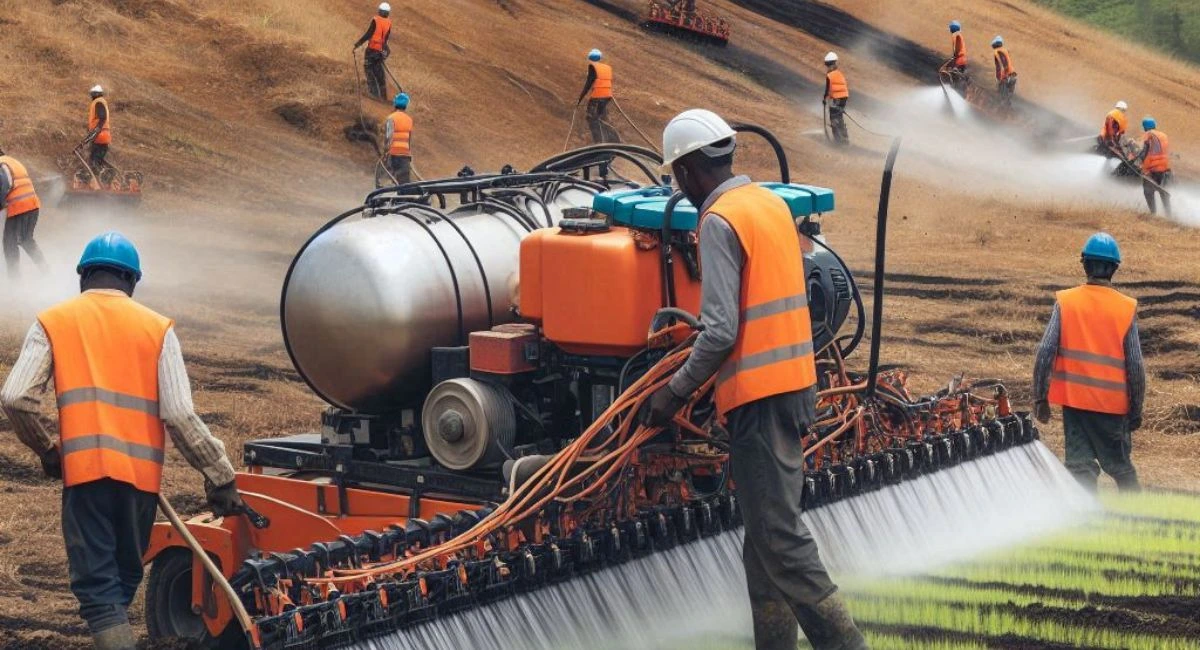Hydroseeding (or spray-on grass, hydraulic mulch seeding, hydro-mulching, hydraseeding) is an increasingly popular landscaping technique known for its affordability, speed, and eco-friendliness. This method has transformed the landscape industry, presenting a viable and sustainable alternative to traditional planting and sodding.
Hydroseeding is widely used in both residential and commercial projects to establish lawns, prevent erosion, and stabilize soil quickly and efficiently. Here, we’ll dive into the hydroseeding process, its numerous advantages, and its applications across various landscapes, from residential lawns to highways and golf courses.
What is Hydroseeding?
Hydroseeding involves spraying a specially prepared “seed slurry” — a blend of water, grass seed, mulch, fertilizer, and tackifiers — over a prepared soil surface. This method helps the seed bind to the ground, allowing it to absorb moisture and nutrients necessary for growth.
Unlike traditional seeding, hydroseeding applies the slurry uniformly, resulting in quicker and more even coverage. This process also ensures that the seeds remain protected, as the mulch in the slurry shields them from harsh environmental elements, retaining the moisture needed for successful germination.
The efficiency and effectiveness of hydroseeding make it particularly valuable for areas that are difficult to reach, steeply sloped, or susceptible to erosion.
Hydroseeding Process
Hydroseeding, often referred to as hydraulic seeding, is a seed application method that combines grass seed, mulch, water, and fertilizers into a slurry. This mixture is then sprayed onto the prepared soil surface using specialized hydroseeding equipment.
The slurry application method ensures even distribution of seeds and nutrients, making it an effective technique for establishing healthy lawns and controlling erosion.
The process begins with site preparation, where the soil is cleared of debris and graded to facilitate proper drainage. Once the site is ready, the hydroseeding slurry is mixed, typically using a combination of grass seed mix, mulch mixture, and a tackifier to help the seed adhere to the soil.
Water retention polymers may also be added to enhance moisture retention, crucial for seed germination. The application of this slurry through mulch spraying creates a protective layer that not only prevents erosion but also provides the seeds with the necessary nutrients to grow.
Unlike traditional seeding, hydroseeding allows for even coverage across large areas, including slopes and hard-to-reach spots, making it particularly effective for erosion control and landscaping. Here’s a step-by-step look at how the hydroseeding process works, from soil preparation to aftercare, ensuring a lush, green landscape in minimal time.
Advantages
The benefits of hydroseeding are versatile, with applications ranging from small residential lawns to large commercial and public projects:

- Residential Lawns: Hydroseeding offers homeowners a quick and efficient way to establish lush green lawns, with benefits in both cost and time compared to sod.
- Commercial Landscapes: Businesses can cover extensive grounds quickly, making hydroseeding ideal for parks, recreational areas, and open green spaces.
- Erosion Control: Hydroseeding is especially beneficial for erosion-prone areas such as hillsides, road embankments, and sloped terrains, where traditional methods struggle to take root.
- Highway and Roadside Vegetation: Hydroseeding is widely used by transportation departments for roadside vegetation, stabilizing soil on highway shoulders and preventing erosion.
- Specialty Uses: Hydroseeding is effective for golf courses, providing fast turf establishment, and is also used for dust control in industrial sites or native grass restoration projects.
Hydroseeding offers several significant advantages over conventional planting methods. One of the standout benefits is erosion control. The mulch in the seed slurry binds the seeds to the soil, creating a barrier that stabilizes the soil and prevents erosion on steep or unstable terrain.
This quality is especially beneficial in construction and environmental restoration projects, where soil stability is crucial. Additionally, the mulch helps retain moisture, supporting faster and more consistent germination, which leads to quicker vegetation cover.
In comparison to sodding, hydroseeding is often more cost-effective, particularly for large-scale applications. It also provides a green solution that uses less water and is easier to apply over expansive or hard-to-access areas, making it an environmentally friendly choice.
Another important benefit is that hydroseeding allows for customized seed mixtures, so the specific grass varieties can be tailored to meet local climate and soil conditions, improving resilience and reducing maintenance requirements.
Applications
Hydroseeding is highly versatile, finding use in both residential and commercial landscapes. For homeowners, hydroseeding is an efficient way to establish a lush, healthy lawn without the expense and labor-intensive process of sodding.
It provides full, even coverage for lawns and gardens and is an excellent option for sloped areas that are more challenging to seed manually. In commercial settings, hydroseeding is used for parks, golf courses, and other recreational areas where quick and uniform turf establishment is essential.
One of hydroseeding’s most impactful applications is in erosion control, where its ability to bind soil is especially valuable. This makes it ideal for roadside embankments, highway shoulders, and hillside stabilizations, where traditional seeding struggles to take hold.
Departments of transportation frequently use hydroseeding for roadside vegetation because it can cover large areas quickly, providing a reliable ground cover that withstands erosion. Other specialty uses include dust control in construction or mining sites, revegetation for ecological restoration, and turf establishment for sports fields.
Materials used in Hydroseeding Slurry
The hydroseeding slurry mixture plays a critical role in its effectiveness:
- Grass Seed Mix: Seeds are chosen based on climate, soil type, and purpose – whether drought resistance, erosion control, or specific aesthetic requirements.
- Mulch Mixture: Mulch, typically made from wood fibers or paper, helps retain moisture, shields seeds from wind and erosion, and maintains optimal germination temperatures.
- Fertilizers: Nutrient-rich fertilizers boost early growth and provide essential minerals for seed development.
- Tackifiers: These binding agents ensure the slurry adheres to the ground, preventing erosion and keeping the seeds anchored.
- Water Retention Polymers: Optional water retention agents are sometimes added to the slurry to maximize moisture retention, especially useful for areas with water limitations.
The slurry mixture in hydroseeding is a carefully crafted blend that maximizes the success of seed establishment. Grass seeds are chosen based on specific requirements such as climate compatibility, erosion control, or drought tolerance.
The mulch component, often made of wood or paper fibers, provides both protection for the seeds and water retention, helping to create an ideal germination environment. Fertilizers are included to promote initial growth, supplying essential nutrients to the emerging plants.
Tackifiers, or binding agents, play an important role in keeping the slurry mixture anchored to the soil, especially on steep terrains where erosion is a concern. In drier areas, water-retaining polymers may also be added to enhance moisture retention, further supporting germination in challenging conditions.
This combination of materials works together to ensure that hydroseeding creates a stable and fertile environment for seed growth, resulting in a thick, healthy grass cover.
Industry-Specific Uses
Hydroseeding has become an essential tool across various industries, including landscaping, environmental restoration, and infrastructure development. In landscaping, hydroseeding offers a green solution for establishing grass quickly and cost-effectively, making it popular for large commercial projects and private lawns alike.
Environmental restoration projects benefit from hydroseeding’s ability to stabilize slopes, restore vegetation, and prevent soil erosion, particularly in post-construction or disturbed areas.
Hydroseeding is also frequently used for turf establishment on golf courses, athletic fields, and parks, where rapid and durable grass cover is a priority. For dust control, hydroseeding is employed in industrial settings to create vegetation cover that suppresses dust emissions, improving air quality and complying with environmental regulations.
In sensitive areas, native grass hydroseeding is used to establish ground cover with species adapted to the local ecosystem, promoting biodiversity and reducing the need for extensive maintenance.
Maintenance and Aftercare
Once hydroseeding is complete, proper aftercare is essential for successful grass establishment. Hydroseeded areas need consistent watering, especially during the first few weeks, with the frequency adjusted based on climate conditions and soil type.
Most grasses start to germinate within seven to ten days, with visible growth often appearing within the first two weeks. Complete coverage is typically achieved within three to four weeks, depending on the seed mix and growing conditions.
Soil pH and nutrient levels should be monitored, as balanced soil encourages healthy growth. Fertilizers can be reapplied as needed to maintain a healthy lawn. Once the grass reaches about three to four inches in height, mowing can begin, promoting denser and more uniform growth.
Following these maintenance steps, hydroseeding offers a reliable and sustainable method to achieve a full, healthy green cover well-suited for diverse applications.
In summary, Hydroseeding is a powerful landscaping tool that combines efficiency, environmental responsibility, and flexibility. Hydroseeding offers a sustainable solution that supports rapid vegetation growth and soil stabilization, whether used for private lawns, commercial properties, or large-scale erosion control.
Its versatility, ease of application, and adaptability make it an attractive choice for various projects, including roadside vegetation, golf courses, and hillside stabilization. With proper care and maintenance, hydroseeding can deliver long-lasting results, establishing lush, resilient grass cover that enhances both the landscape and the environment.

